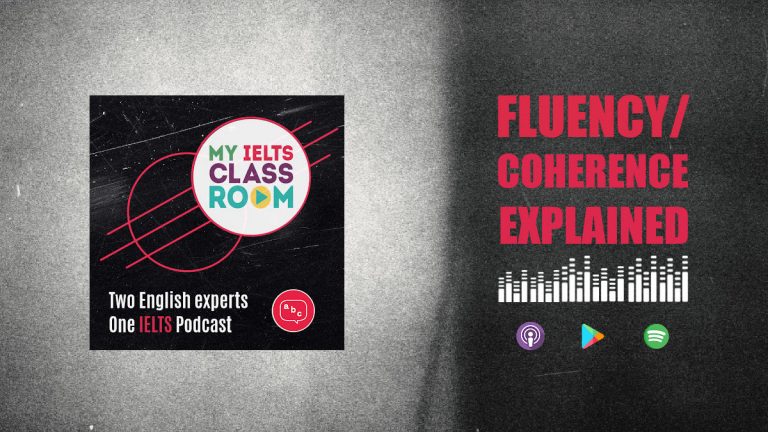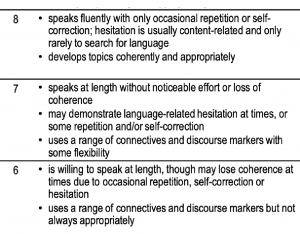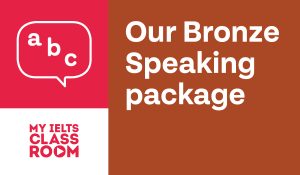
How will the examiner score your IELTS speaking Fluency and Coherence?
In the IELTS Speaking exam, the examiner will give you a score in 4 areas: Fluency and Coherence, Lexical Range, Grammatical Range and Accuracy, and Pronunciation. Your final score will be the average of these four scores rounded down (yes, you read that correctly, the scores will be rounded down, so you will need an average of at least 7.0 to achieve that score). However, recently I realised that that there is a lot of confusion among students as to exactly what the examiner is looking for when they grade IELTS speaking Fluency and Coherence.
Fluency is relatively clear and easy to understand – that is your ability to speak without pauses or hesitations for languages. But what exactly is “coherence”?
The band descriptors tell us that it is the use of “connective devices and discourse markers”, but are discourse markers the same as transition signals? And what exactly are connective devices in speech? That is what Nick and I explain in today’s episode.
Plus, if you would like to join our IELTS speaking challenge next week, you can choose from the following questions and email your recording to hello@myieltsclassroom.com
- a well-known and popular person in your country
- a time when you made a hard decision which had a positive result
- something you do to stay fit & healthy
- a traditional product from your country
What do the band descriptors tell us about IELTS speaking fluency and coherence?
The band descriptors explain that that there are two clear elements to Fluency and Coherence
- the ability to speak without repetition, self-correction, of hesitation
- the ability to develop topics coherently by using connectives and discourse markers

As the descriptions for fluency appear first inside each band, that tells us that this what the examiner will focus on most heavily when deciding between bands. In other words, if you are not able to speak without pausing for language, then you are not going to be able to score a 7 or 8 in IELTS speaking Fluency and Coherence even if you use connectives well.
However, I think that the main confusion about FC comes from students misunderstanding exactly what “connectives” and “discourse markers” are. Two weeks ago, Nick and I ran a podcast that looked at 5 recent IELTS cue card topics. As part of the lesson, we each took one topic and gave a model answer. A week later, I received an email from a student who told me that they could find no evidence in either of our answers of “discourse markers”. This confused me as, even though I had not intentionally used any, I knew that I must have included some inside my 2-minute response, because as a native speaker it is just natural for me to do so.
Then it dawned on me – the student doesn’t understand what a discourse marker is.
Sure enough, when I emailed back to ask them to provide some examples of what they think discourse markers are, they replied with words like “moreover”, “consequently”, and “on the other hand”. These are transition signals, not discourse markers! Yes, they are words that show the relationship between ideas, but these are appropriate in writing not speaking!
The importance of discourse makers in IELTS speaking Fluency and Coherence
What are discourse markers then? Well, very simply they are words or phrases that signal to the listener either what type of information you are going to give next, or how you feel about that information. There are literally dozens of these in English, and I bet that you are already using many of them naturally without even realising it.
In the lesson, we give a brief explanation of the following discourse markers, but I think that their meaning is clear even without the explanation!
Adverbs that signals how you feel about what you are going to say next:
- Unfortunately
- Luckily, Thankfully
- Obviously, Clearly, Of course
- Naturally, Understandably
- Stupidly. Foolishly
- Honestly
- Amazingly
A phrase that signals the type of information you are going to give next:
- Basically
- In fact
- As you know
- On the whole
- Generally
A phrase that changes the topic of discussion or moves it forward
- Anyway
- Another problem, Another point, Another reason
- I just want to add
A phrase that shows you want to return to a previous subject
- Like I said,
- Going back to
- As I was saying
As I said, this is NOT an exhaustive list of all of the discourse markers in English. However, there is more than enough here for any IELTS test-takers to use to get a 7.0 or higher. However, the key to getting a high score for IELTS Speaking Fluency and Coherence is being able to use these words and phrases naturally. The best way to do this is to expose yourself to as much spoken English as you can. Listen to the British or American radio; watch TV shows; download podcasts. You will find that all native speakers used these expressions (and more) in their speech, so listening to them doing so naturally is usually all you need to start using them yourself.
Other aspects of IELTS speaking fluency and coherence
In fact, discourse markers are only one element of cohesion. There are other speech features that the examiners will be listening for in your exam.
- Using referencing: Are you able to use pronouns like he / she / it to refer back to people or things you have already mentioned. Or “this” to summarise an idea?
- Logically sequencing your ideas: Are you able to organise your ideas in a way that is easy to follow? Or is the examiner confused because there are details missing, or you are repeating ideas?
- Giving answers that are relevant: How relevant are you spoken sentences in relation to the question given (this usually comes into play more in Part 3)?
- Using fillers naturally: Are you able to use short phrases like “um” or “you know” or “like” between content words to “fill” the short pauses between your ideas?
- Using pausing naturally: Do you PAUSE naturally to show when one idea has ended and another is about to begin? Or are you able to end a turn in Part 3 to give the examiner chance to ask another question. This is called turn-taking and is a feature of high-level candidates.
In the lesson, you will have the chance to listen to Shelly giving one more model answer to check if she is using all of these features of good cohesion. Then, you can start recording and listening to your own responses to see if you are doing the same!
Would you like expert help to improve your IELTS speaking score?
We offer a 5-day intensive course for IELTS test-takers every month that covers all aspects of speaking, from how to approach each section to how to paraphrase well or address the most difficult questions in Part 3. Even better, with every course being run by an ex-examiner, you will be getting feedback is guaranteed to help you to improve your score. You can read more about the course here.

